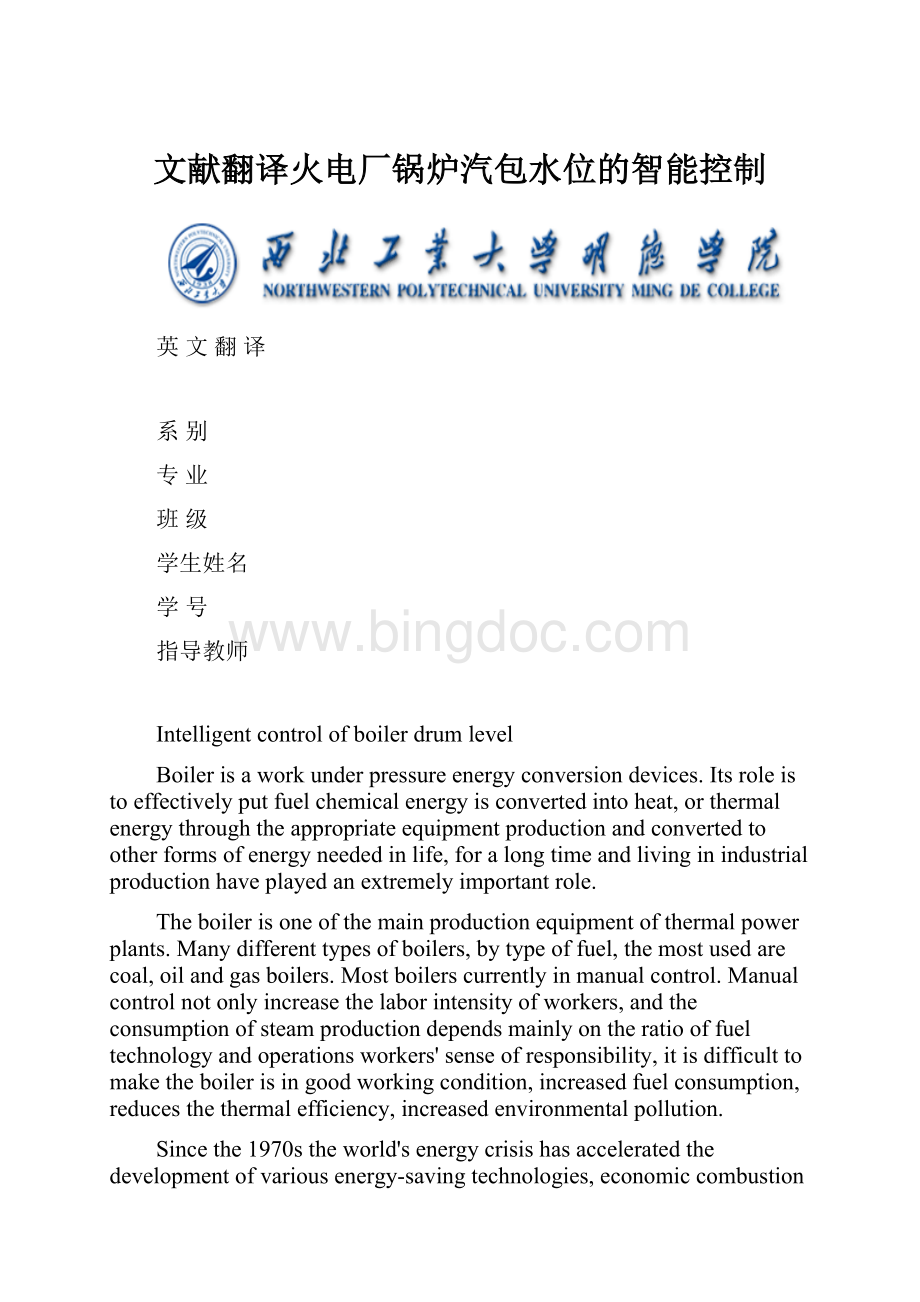文献翻译火电厂锅炉汽包水位的智能控制.docx
《文献翻译火电厂锅炉汽包水位的智能控制.docx》由会员分享,可在线阅读,更多相关《文献翻译火电厂锅炉汽包水位的智能控制.docx(7页珍藏版)》请在冰点文库上搜索。

文献翻译火电厂锅炉汽包水位的智能控制
英文翻译
系别
专业
班级
学生姓名
学号
指导教师
Intelligentcontrolofboilerdrumlevel
Boilerisaworkunderpressureenergyconversiondevices.Itsroleistoeffectivelyputfuelchemicalenergyisconvertedintoheat,orthermalenergythroughtheappropriateequipmentproductionandconvertedtootherformsofenergyneededinlife,foralongtimeandlivinginindustrialproductionhaveplayedanextremelyimportantrole.
Theboilerisoneofthemainproductionequipmentofthermalpowerplants.Manydifferenttypesofboilers,bytypeoffuel,themostusedarecoal,oilandgasboilers.Mostboilerscurrentlyinmanualcontrol.Manualcontrolnotonlyincreasethelaborintensityofworkers,andtheconsumptionofsteamproductiondependsmainlyontheratiooffueltechnologyandoperationsworkers'senseofresponsibility,itisdifficulttomaketheboilerisingoodworkingcondition,increasedfuelconsumption,reducesthethermalefficiency,increasedenvironmentalpollution.
Sincethe1970stheworld'senergycrisishasacceleratedthedevelopmentofvariousenergy-savingtechnologies,economiccombustionboilerhasbecomeaveryimportantissue.Ourscientificandtechnicalpersonnel,computercontrolledboilermadeofextensiveresearch,hasmadegratifyingachievements.Duetotheuseofcomputercontrol,theboilercanbeimprovedingoodrunningcondition,thethermalefficiencyoftheboiler,steamproductionandquality,tothecity,sothatthesecondaryproductquality,quantityandsafetyaretoimproveeconomicefficiencyisveryimpressive.Becauseofthis,theboilermicrocomputercontrol,hasbecomeanimportanttaskoftransformation.
Traditionalcontrolmethodsincludeclassicalcontrolandmoderncontrol,isbasedontheprecisecontrolofthecontrolledobjectmodel,lackofflexibilityandadaptability,suitabletosolvetheinvarianceproblemisrelativelysimplecontroloflineartime.Thetraditionalwayofintelligentcontrolisacontroloracontrolsystem,ifitcaneffectivelyovercomethecontrolledobject(process)andtheenvironmentwithahighdegreeofcomplexityanduncertainty,andtoachievethedesiredgoal,thensaidthiscontrolmethodfortheintelligentcontrol,sayingsuchacontrolsystemfortheintelligentcontrolproblems.
Intheproductionpractice,complexcontrolproblemscanbeexperiencedandskilledoperatorscontroltheorycombinedtosolvetheresultingintelligentcontrol.Themethodforcontrollingintelligentcontroltheoryandartificialintelligencetechniquestocombineaflexible,objectothercontrolmethodstoadaptthecomplexityanduncertainty.
Intelligentcontrolisthecontroltheoryadvancedstageofdevelopment,itismainlyusedtosolvethecomplexsystemofcontrolproblemswithtraditionalcontrolmethodsaredifficulttosolve.Intelligentcontrolstudyhasthefollowingfeatures:
(1)uncertaintyinthemodel.Intelligentcontroladaptedtocontroltheobjectofuncertainty,theuncertaintiesincludetwomeanings:
First,themodelisunknownorpoorlyunderstood;Second,thestructureandparametersofthemodelmayvaryoverawiderange.
(2)ahighdegreeofnon-linearity.Intelligentcontrolmethodscansolvetheproblemofnonlinearcontrolsystems.
(3)complexmissionrequirements.
Intelligentcontrolhasthreeimportantbranch,namelyfuzzycontrol,neuralnetworkcontrolandgeneticalgorithms.
(1)FuzzyControl
Variousconventionalmethodsareconventionalcontrolisbasedonthemathematicalmodelofthecontrolledobjectonthebasisofprecise,butasthecomplexityofthesystemincreases,thesystemwillbedifficulttoestablishaprecisemathematicalmodel.
Inengineeringpractice,itwasfoundthatacomplexcontrolsystemoperatorbyapersonwithawealthofpracticalexperiencesatisfactorycontroleffect.Thisshowsthat,ifthehumanbrainthroughtheanalogcontrollerdesignthinkingcanachievecontrolofcomplexsystems,resultingfuzzycontrol.
Developmentoffuzzycontrolcanbedividedintothreephases:
①1965-1974,thefirstphaseofthedevelopmentoffuzzycontrol,fuzzymathdevelopmentandformationstage;
②1974-1979,thefuzzycontrolofthesecondphaseofdevelopment,resultinginasimplefuzzycontroller;
③1979tonow,fuzzycontrolthirdstageofdevelopment,namelyhighperformancefuzzycontrolstage.
(2)neuralnetworkcontrol
Neuralnetworkshavedecadesofhistory.In1943,McCullochandPittsneuronproposedmathematicalmodel;1950-1980fortheformationofneuralnetworks,withasmallamountoftheoutcome;since1980forthedevelopmentofneuralnetworks.
Theneuralnetworkisintroducedtoformacontrolfieldneuralnetworkcontrol.Neuralnetworkcontrolfromthephysiologicalmechanismofthehumanbrainsimulationsystemstructureissimpleanemergingintelligentcontrolmethods.Neuralnetworkhasthecharacteristicsofaparallelmechanism,patternrecognition,memoryandlearningability,itcanfullyapproximateanycomplexnonlinearsystems,abletolearnandadapttothedynamiccharacteristicsofuncertainsystemswithrobustnessandfaulttolerance.NeuralNetworkControlinthecontrolfieldhasawiderangeofapplications.
(3)geneticalgorithm
Thegeneticalgorithmisanimportantbranchofartificialintelligence,isthesearchalgorithmbasedontheprincipleofnaturalselectionandgenetics,andisbasedonDarwin'stheoryofevolution,simulatedlifeonacomputerevolutionmechanismanddevelopedascience.CurrentlyGeneticalgorithmshavebeenwidelyusedinmanypracticalproblems,newideasandnewmethodsbecomehardtosolvehighlycomplexproblems.
Geneticalgorithmscanbeusedtooptimizelearningandfuzzyneuralnetworkparametersandweightcontrolrulesinthefieldofintelligentcontrolofawiderangeofapplications.
Intelligentcontrolisthelateststageofdevelopmentofautomaticcontrolismainlyusedtosolvecomplexcontrolproblemsdifficulttosolvetraditionalcontrol.
Asanadvancedstageofdevelopmentofintelligentcontrol,intelligentcontrolmainlytosolvethecontrolproblemthatcomplexsystemsaredifficulttoresolvewithtraditionalcontrolmethods,includingtheintelligentrobotcontrol,computerintegratedmanufacturingsystems,industrialprocesscontrol,aerospacecontrol,socio-economicmanagementsystem,transportationsystems,environmentalprotectionandenergysystems.
(1)ApplicationinRobotControl:
intelligentrobotresearchcurrentlythehottopic.Currentlyusedinover90%oftheindustrialrobotisnotintelligent.Withtherapiddevelopmentofrobottechnology,withvaryingdegreesofintelligencerequiresavarietyofrobots.
(2)applicationinprocesscontrol:
processcontrolandautomationtechnologyisanimportantaspect.Intelligentcontrolinprocesscontrolhasbeenwidelyused.
Sincethe1960s,duetothetechnology,computertechnologyandartificialintelligencedevelopment,researchscholarsinthecontrolcommunityself-organizing,self-learningcontrolbasedonself-learningabilityinordertoimprovecontrolsystems,begantopayattentiontoartificialintelligencetechniquesandmethodsappliedtothecontrol.
Inrecentyears,neuralnetworks,fuzzymathdevelopment,expertsystems,evolutionandotherdisciplinestointelligentcontrolintoatremendousvitality,therebyproducingavarietyofintelligentcontrolmethods.
火电厂锅炉汽包水位的智能控制
锅炉是一种承受一定工作压力的能量转换设备。
其作用就是有效地把燃料中的化学能转换为热能,或再通过相应设备将热能转化为其它生产和生活中所需的能量形式,长期以来在工业生产和居民生活中都扮演着极其重要的角色。
锅炉是火电厂的主要生产设备之一。
锅炉种类很多,按燃料分类,用的最多的有燃煤、燃油和燃气锅炉。
多数锅炉目前处于人工控制状态。
人工控制不仅加大了操作工人的劳动强度,而且燃料的消耗量与蒸汽生产量的比值主要取决于操作工人的技术水平和工作责任心,难以使锅炉处于良好的工况,增加了燃料消耗,降低了锅炉热效率,增加了环境污染。
自70年代世界发生能源危机以来,加速了各种节能技术的发展,锅炉的经济燃烧也成了十分重要的课题。
我国的科技人员,对锅炉的微机控制作了大量研究,取得了可喜的成果。
由于采用微机控制后,锅炉可以在良好的工况下运行,锅炉的热效率,蒸汽生产量和品质,都会的到改善,从而使二次产品质量,数量和安全性都的到提高,经济效益是十分可观的。
正因为如此,锅炉的微机控制,已成为重要的技术改造任务。
传统控制方法包括经典控制和现代控制,是基于被控对象精确模型的控制方式,缺乏灵活性和应变能力,适于解决线性时不变性等相对简单的控制问题。
传统的智能控制就是一种控制方式或一种控制系统,如果它能够有效地克服被控制对象(过程)和环境所具有的高度复杂性和不确定性,并且能够达到所期望的目标,那么称这种控制方式为智能控制,称这样的控制系统为智能控制问题。
在生产实践中,复杂控制问题可通过熟练操作人员的经验和控制理论相结合去解决,由此产生了智能控制。
智能控制将控制理论的方法和人工智能技术灵活地结合起来,其他控制方法适应对象的复杂性和不确定性。
智能控制是控制理论发展的高级阶段,它主要用来解决那些用传统控制方法难以解决的复杂系统的控制问题。
智能控制研究对象具备以下一些特点:
(1)不确定性的模型。
智能控制适合于不确定性对象的控制,其不确定性包括两层意思:
一是,模型未知或知之甚少;二是,模型的结构和参数可能在很大范围内变化。
(2)高度的非线性化。
采用智能控制方法可以较好地解决非线性系统的控制问题。
(3)复杂的任务要求。
智能控制有3个重要分支,分别为模糊控制,神经网络控制以及遗传算法。
(1)模糊控制
以往的各种传统控制方法均是建立在被控对象精确数学模型的基础上,然而,随着系统复杂程度的提高,将难以建立系统的精确数学模型。
在工程实践中,人们发现,一个复杂的控制系统可由一个人操作人员凭借着丰富的实践经验得到满意的控制效果。
这说明,如果通过模拟人脑的思维方法设计控制器,可实现复杂系统的控制,由此产生了模糊控制。
模糊控制的发展可分为3个阶段:
①1965-1974年,模糊控制发展的第一阶段,模糊数学发展和形成阶段;
②1974-1979年,模糊控制发展的第二阶段,产生了简单的模糊控制器;
③1979年至现在,模糊控制发展的第三阶段,即高性能模糊控制阶段。
(2)神经网络控制
神经网络的研究已经有几十年的历史了。
1943年,McCulloch和Pitts提出了神经元数学模型;1950-1980年为神经网络的形成期,有了少量成果;1980年以后为神经网络的发展期。
将神经网络引入控制领域就形成了神经网络控制。
神经网络控制是从机理上对人脑生理系统进行简单结构模拟的一种新兴智能控制方法。
神经网络具有并行机制、模式识别、记忆和自学能力的特点,它能充分逼近任意复杂的非线性系统,能够学习与适应不确定系统的动态特性,有很强的鲁棒性和容错性。
神经网络控制在控制领域有着广泛的应用。
(3)遗传算法
遗传算法是人工智能的一个重要分支,是基于自然选择和基因遗传学原理的搜索算法,是基于达尔文进化论,在计算机上模拟生命进化论机制而发展起来的一门科学。
目前遗传算法已经被广泛应用于许多实际问题,成为用力解决高度复杂问题的新思路和新方法。
遗传算法可用于模糊控制规则的优化及神经网络参数及权值的学习,在智能控制领域有广泛的应用。
智能控制是自动控制发展的最新阶段,主要用于解决传统控制难以解决的复杂的控制问题。
作为智能控制发展的高级阶段,智能控制主要解决那些用传统控制方法难以解决的复杂系统的控制问题,其中包括智能机器人控制、计算机集成制造系统、工业过程控制、航空航天控制、社会经济管理系统、交通运输系统、环保及能源系统等。
(1)在机器人控制中的应用:
智能机器人是目前机器人研究中的热门课题。
目前工业上用的90%以上的机器人都不具有智能。
随着机器人技术的迅速发展,需要各种具有不同程度智能的机器人。
(2)在过程控制中的应用:
过程控制是自动化技术的一个及其重要的方面。
智能控制在过程控制中有着广泛的应用。
从20世纪60年代起,由于空间技术、计算机技术及人工智能的发展,控制界学者在研究自组织、自学习控制的基础上,为了提高控制系统的自学能力,开始注意将人工智能技术与方法应用于控制中。
近年来神经网络、模糊数学、专家系统、进化论等各门学科的发展给智能控制注入了巨大的活力,由此产生了各种智能控制方法。